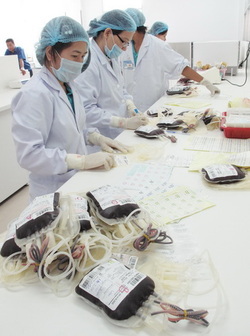Things to know about Cord Blood Donation,
Collection, Preservation and Transplant

Cord
blood also termed as Umbilical Cord is actually the blood that is preserved in
the placenta and umbilical cord during the time of delivery of baby. In such
circumstances, the blood is usually discharged after the delivery. However, now
surgeons have found that it is valuable resource of stem cells, cord
blood collection and cord blood donation have become a great and viable
alternative to bone marrow in millions of successful transplants.
Benefits of cord blood collection and preservation
The very first benefit of cord blood collection and stem cell banking is that they can be easily extracted without much pain and risk for the infant and the mother. The umbilical cord stem cells have higher risks of engraftment, through more forbearing on HLA mismatches and reduced chances of being contaminated with dormant viruses. Moreover, the body accepts the cord blood cells much better than bone marrow. In addition, the preserved cord blood stem cells can be easily accessible to allow the patients to get the treatment earlier if needed without much waste of time in the matching process as in cases of banked blood cells. Moreover, most of the blood banks may not charge anything to retrieve the stored stem cells of the infants if required for transplant later on.
There are several other benefits of cord blood banking. In most cases, the matched cord blood stem cells required for cord blood transplants may be difficult to retrieve due to matching requirements. The blood cells taken from the infants are perfect match for them over their lifetime. In the circumstances when the baby is infected with a disease that must be treated with radiation or chemotherapy, there is high probability that it may cause negative impact on the internal organs and immune system. As self transplant is not always the appropriate procedure for treating every disease, Cord blood preservation may have the benefits to repopulate and bolster the blood and immune system of the infants as a result of impediment from other surgical treatments.
Other advantages of cord blood banking
In addition, cord blood cells from an infant have 25 percent chances of matching with a sibling. By using these genetically correlated stem cells that are uninfected from disease being treated, it often results in achieving successful transplants with reduced chances of complications. The cord blood stem cells are protected against most diseases. For this reason, cord blood or umbilical blood may have great usages in the near future beyond imagination in the field of cell and cord blood transplants. In the future, medical technology may take help of umbilical cord stem cells to reconstruct cardiac tissues or operate and repair damages due to spinal cord injuries and stroke and hopefully reverse the impacts of disease such as Parkinson’s, and multiple sclerosis. When people donate cord blood, they help others by making it available when required in future. It is a valuable investment for many families as cord blood cost less than money spent on children’s schooling.
Benefits of cord blood collection and preservation
The very first benefit of cord blood collection and stem cell banking is that they can be easily extracted without much pain and risk for the infant and the mother. The umbilical cord stem cells have higher risks of engraftment, through more forbearing on HLA mismatches and reduced chances of being contaminated with dormant viruses. Moreover, the body accepts the cord blood cells much better than bone marrow. In addition, the preserved cord blood stem cells can be easily accessible to allow the patients to get the treatment earlier if needed without much waste of time in the matching process as in cases of banked blood cells. Moreover, most of the blood banks may not charge anything to retrieve the stored stem cells of the infants if required for transplant later on.
There are several other benefits of cord blood banking. In most cases, the matched cord blood stem cells required for cord blood transplants may be difficult to retrieve due to matching requirements. The blood cells taken from the infants are perfect match for them over their lifetime. In the circumstances when the baby is infected with a disease that must be treated with radiation or chemotherapy, there is high probability that it may cause negative impact on the internal organs and immune system. As self transplant is not always the appropriate procedure for treating every disease, Cord blood preservation may have the benefits to repopulate and bolster the blood and immune system of the infants as a result of impediment from other surgical treatments.
Other advantages of cord blood banking
In addition, cord blood cells from an infant have 25 percent chances of matching with a sibling. By using these genetically correlated stem cells that are uninfected from disease being treated, it often results in achieving successful transplants with reduced chances of complications. The cord blood stem cells are protected against most diseases. For this reason, cord blood or umbilical blood may have great usages in the near future beyond imagination in the field of cell and cord blood transplants. In the future, medical technology may take help of umbilical cord stem cells to reconstruct cardiac tissues or operate and repair damages due to spinal cord injuries and stroke and hopefully reverse the impacts of disease such as Parkinson’s, and multiple sclerosis. When people donate cord blood, they help others by making it available when required in future. It is a valuable investment for many families as cord blood cost less than money spent on children’s schooling.
